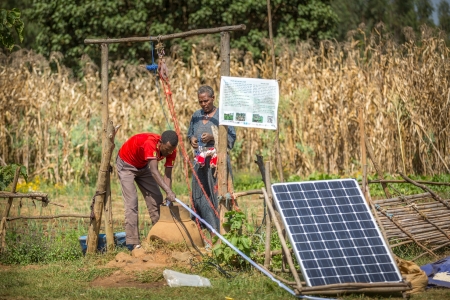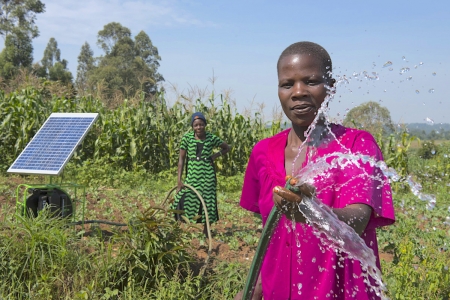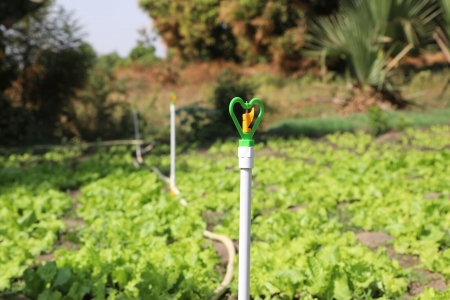Celebrating over a decade of a policy research partnership between the International Water Management Institute (IWMI) and the Sir Ratan TATA Trust, the IWMI-TATA Water Policy Program's Annual Partners' Meeting began today in Anand, India. Researchers and partners are presenting their work on irrigation, energy, agriculture and livelihoods. The Agriculture and Ecosystems blog will feature highlights from the meeting over the next couple of weeks.
Cheaper and increasingly more powerful solar-powered water pumps are lifting more than groundwater in parts of India. They are also lifting farmers out of poverty by enabling them to better irrigate their crops more affordably, with less dependence on electric and diesel-powered pumps. But while it is clean energy, will they bring environmental costs?
Typically, power supply is either too poor or non-existent for farmers to adequately irrigate their fields. A long-established system involved distributing irrigation canal water to farm ponds once every two or three weeks. Farmers would extract this water with shallow, electric or diesel surface pumps to irrigate their fruit orchards, flower and cotton fields. A steady decline in this on-off supply of canal water has led to increasing irrigation water stress. Even this would be suspended once a year for canal maintenance work for up to 40 days, leaving farmers literally high and dry.
Solar Powered Pumps
To supplement the intermittent and inadequate canal supply, many farmers have also dug tubewells. Throughout India, 20 million small electric or diesel-powered pumps have been installed to date by 55-60% of the population. For farmers,waiting two to three years for connection to the national grid only adds to their woes. Looking for solutions to the poor electricity distribution and spiralling costs of diesel, they have been demanding solar power to meet the shortfall in energy to irrigate their fields.
The technology has been around for two or three decades but it’s not a perfect solution for powering irrigation. Too expensive for most farmers, the panels were only available in one or two horsepower (hp) output and inadequate for groundwater extraction from deeper tubewells.
Subsidies make solar pumps a viable option for more farmers
A new study by Nidhi Prabha Tewari for the IWMI-Tata Water Policy Program highlights a scheme by the Rajasthan government offering massive (86%) subsidies on 3 hp solar pumps costing $11,000. To date, over 7,000 have popped up across India, generating enough energy to irrigate small plots of 1 - 1.12 hectares. New providers in the market are producing solar integrators which have brought the cost of a similarly powerful pump, down to $3,000. With costs plummeting and savings on diesel as much as $1 – 2,000 a year, the cheaper solar pumps are suddenly a viable option for many more farmers. But the lack of power storage facilities and cloudy or rainy weather means solar pumps are still supplementary to normal pumps.
Innovating at domestic level, individuals are adding inverters and batteries to leverage the technology, providing more energy for their domestic or cottage industry use such as small mills. Solar pumps are not only emerging as an answer with huge potential for the agriculture sector’s energy problems. They are also bringing savings to farmers for whom they are pumping as well as energy solutions.
Will this spark excessive groundwater extraction?
 A solar-powered pump installed at a farm irrigation pond in Rajasthan. Photo credit: Nidhi PrabhaTewari
A solar-powered pump installed at a farm irrigation pond in Rajasthan. Photo credit: Nidhi PrabhaTewari
Groundwater irrigation has been a major factor in raising many from poverty in developing countries. But with growing awareness of the groundwater-energy nexus, comes concern for the management of solar-powered groundwater extraction. With the previous state management of water supply for farm irrigation, there was a great deal of control. Will increasing installations of solar pumps lead to unsustainable groundwater extraction, sinking water tables and water quality?
With electric or diesel pumps, farmers could quantify the cost which was a financial control on pumping. Once the initial cost of solar pumps was recovered (usually a year or so), running costs disappeared. The situation isn’t helped by famers complaining that 3 hp is not enough and are demanding 5 and 10 hp solar pumps. As pumping groundwater becomes cheaper and easier, researchers are mindful of its environmental impact. IWMI’s Nidhi Tewari says, “Although policy makers don’t fully appreciate the implications, they have tried tying the subsidised solar pumps to drip irrigation.” But will it lead to excessive extraction? Tewari thinks it’s too early to say. “Solar pumps installed at tubewells in farms not supplied by canal water are a bigger concern.” She adds, “It would be great to promote solar surface pumps in eastern India which is rich in water and deficient in electricity.”
It will be interesting to see whether the new lower cost pumps on the market will affect the subsidised state scheme and whether it will be rolled out elsewhere. So while India’s farmers look forward to more prosperous lives, the government must look for innovative answers to management that doesn’t remove those hard-earned benefits.
Sources
Groundwater and Human Development: Challenges and Opportunities in Livelihoods and Environment. Tushaar Shah, IWMI
Solar Irrigation Pumps: The Rajasthan Experience. NidhiPrabhaTewari.




/index.jpg?itok=EzuBHOXY&c=feafd7f5ab7d60c363652d23929d0aee)











Comments
good information thank you very much
Your article is very good. Water pumps are instrumental in helping the fields of many farmers
good information thank you
Who are the manufacturers of the solar powered pumps?
Hi Rob,
Sorry for the delayed reply. Please send me your email address and I will find out the information for you.
Thanks.
Well said, but people need to appreciate that adding Solar in their house is an purchase which will raise the longer term valuation of their building if / when they choose to sell. With the environment the way it is going we are not able to underestimate any product or service that offers no cost power at no cost to both the client and more notably the environment!
Thanks for your comment, Angel. I agree that solar panels are an investment which goes beyond agriculture. However, that may not be the prime or initial concern of these, and especially subsistence farmers. Hopefully, they will appreciate the benefits of all the applications that become within their reach with this technology.
Hello Dharshani,
Thank you for this interesting post. I had also attended the IWMI-Tata policy programme in Anand. We had demonstrated a small surface solar pump at this meet and it garnered interest from a lot of participants. I happened to stumble across your post today and have written to Rob Crook directly.
Thanks
Amit
Amit: Thank you and I hope these actions will bring some direct benefits to more farmers and sustainable use of their groundwater resources.
Hi Dharshani, not only you post is informative but also timely and apt as the soon to be launched Greenpeace contest, which is based upon replacing dirty Diesel Pumps with new innovation/design pumps based on Renewable Energies esp. Solar, that you talked about! Check the link https://greenpeacechallenge.jovoto.com/blog/posts/human-powered-pumps-a-v...
Here I have a small favor to ask for..do you have a list of potential designers/practitioners to be approached for the above contest? If yes, can you share it with me pls?
good one
hi i want to buy solar water lifting pump kindly tell me the contact details of manufacturer in india
Hi,
This is really a very important and valuable post. Thanks for a worth share!!
Irrigation Pumps
Do you have the Operation and Mainteanace cost of the sysytem -.Is it cost effective ? Is there any study about this?
More information on installation of solar powered pump.
Nice post! Now these days solar energy is widely used for store the electricity. Due to lack of electricity some of the big organization used the solar pump up for power savings. Due to need of excellent water storage system people are looking the best and effective schemes. Solar water pumps are easily installed, without trenching embedding, construction cost savings, especially for the places of power shortage and difficult to cable sections, the solar pump up are more practical.
Water pumps are something that interest me. I am looking to learn more about pumps dealing with solar power. It is nice to know that they are a viable option for some farmers. It is awesome to think that water can be pumped and energy can be conserved at the same time.
https://store.waterpumpsupply.com/castiron.html
Dear Darshani
Nice article.
can i have access to the entire report please
regards
chaitanya d sangawar
These solar water pump supplier in india are extremely cost-effective, durable, easy to install and require minimum maintenance. The life of an installed pump can be as long as 20 years. The maintenance and running cost is also very low as compared to the normal water pumps.
https://www.solarpumpindia.net/